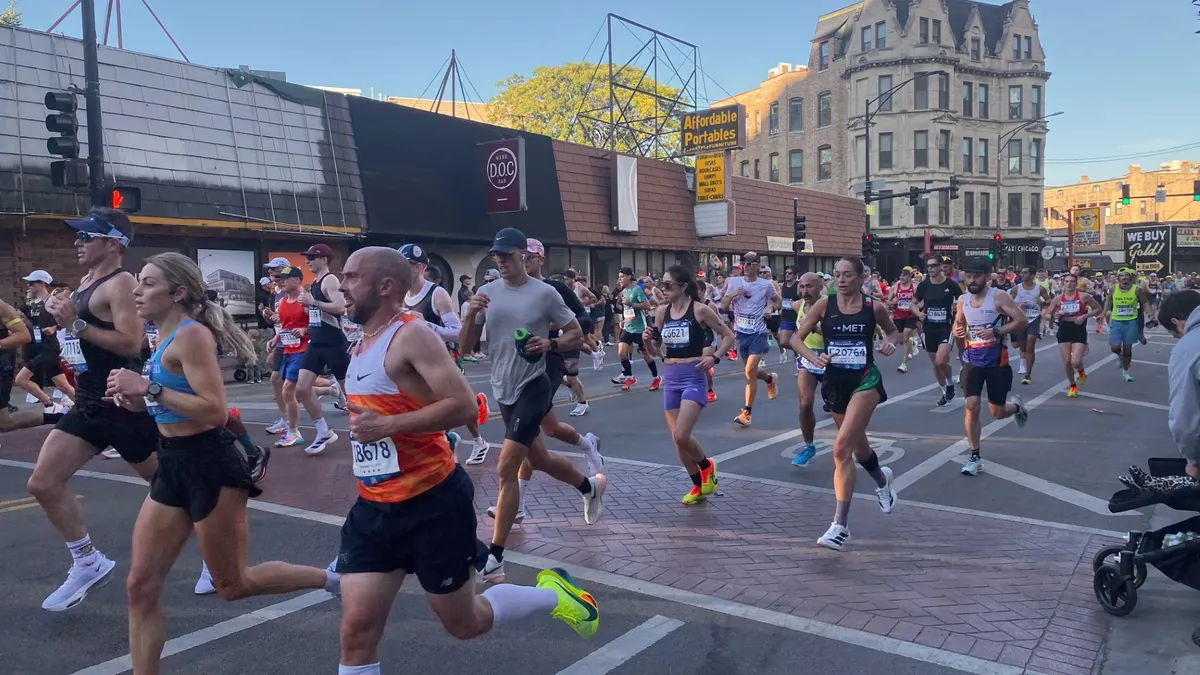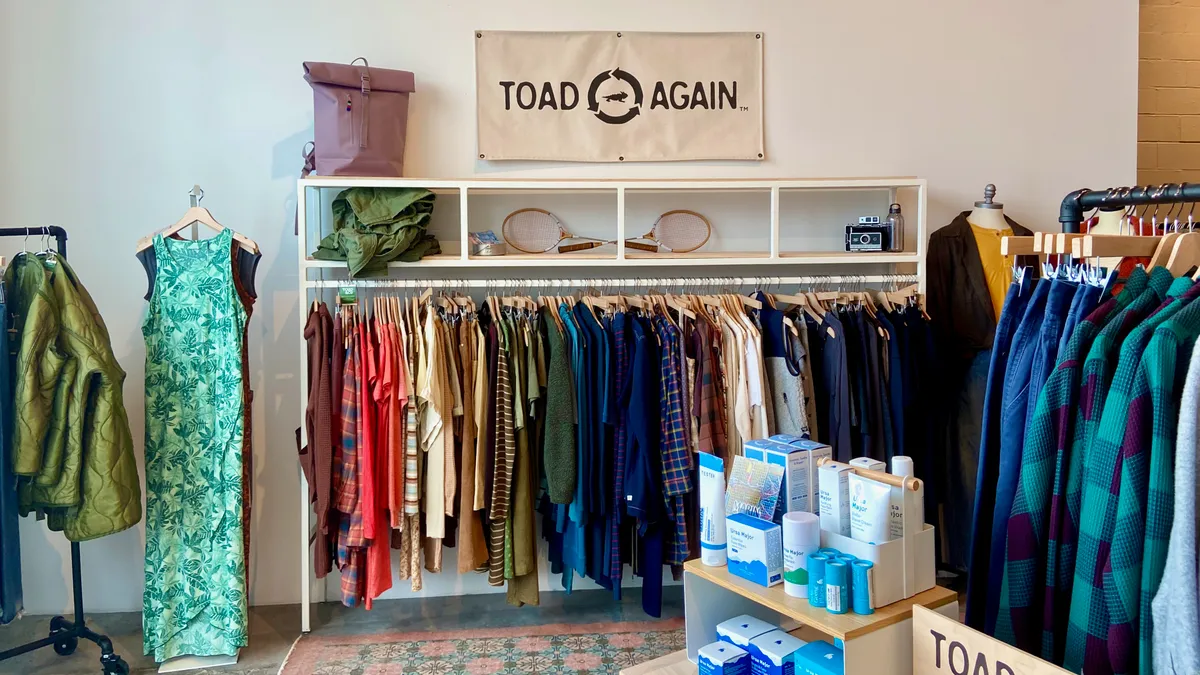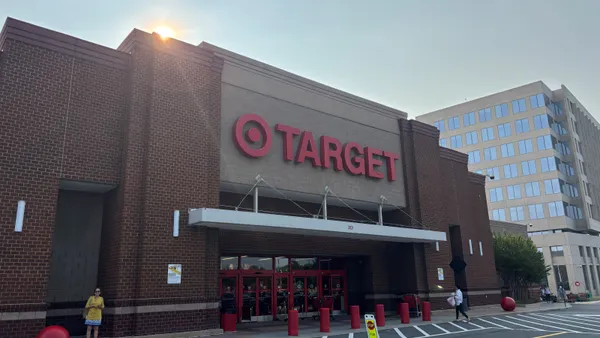New York City is one of the world's great fashion capitals, and its Manhattan-focused Garment District has long been the axis upon which that reputation turned. The area, which roughly encompasses the streets between 35th Street and 40th Street, and the avenues between Broadway and Ninth, has been protected by strict zoning laws since 1987.
But times have changed. New York City has lost 95% of its manufacturing workforce since its heyday in the 1950s, and a 2011 report from the New York City Economic Development Corporation (NYCEDC), a non-profit centered on economic growth in New York City, indicated that fashion manufacturing jobs in NYC had further declined 61% since 2001. Recently, the Garment District Alliance reported that "from March 2017 to March 2018, New York City's apparel manufacturing industry shrunk by an additional 7.7%, a loss of approximately 1,000 jobs." And as of August 2018, the AP estimated that only 5,000 garment manufacturing workers remained.
This isn't just a New York City problem, though. Manufacturing in the United States — particularly in the fashion sector — has dropped precipitously over the past 30 years. In 2012, the U.S. Department of Commerce reported that "since 1990, employment in apparel, leather, and allied product manufacturing has shrunk by 912,000 jobs, or 84 percent." The bulk of remaining jobs are located in California, New York and Texas. Furthermore, according to a 2017 report from the Bureau of Economic Analysis, U.S. textile and apparel manufacturing represented only 0.16% of the GDP in 2015, down from 0.57% in 1998.
In addition to a waning apparel manufacturing industry, New York's Garment District faces encroaching development from office space conversions — WeWork, for example, recently took over 7 floors in the heart of the area. Combine that with a steady flow of apparel brands looking to leave Manhattan for the promise of less expensive rents in other boroughs — and the lower cost of overseas manufacturing — and it's no wonder the situation on and around Fashion Avenue looks grim.
Preserving the district
In February 2017, New York City Mayor Bill de Blasio's office revealed that it was planning to rezone the Garment District and remove some of the outdated restrictions. At the same time, the city planned to develop a Made In NY Campus in Brooklyn's rapidly gentrifying Sunset Park district, using the city-owned Bush Terminal to provide lower-cost space to apparel industry brands.
The move would create a large fashion center, split between Industry City and the Made in NY campus at the Bush Terminal. Bush Terminal is what remains of an original parcel of land with the same name that decades ago was divided into two parcels: one parcel was sold to the city and retained the Bush Terminal name, and the other parcel remained privately owned and was renamed Industry City. The Mayor’s Made in NY campus is coming to the city-owned Bush Terminal. Industry City is an adjacent property offering space for creative types, manufacturing and events. Together, the two adjacent spaces are creating NYC's second largest fashion hub after Manhattan's Garment District.
In March 2017, the NYCEDC, along with the Council of Fashion Designers of America (CFDA) and the Garment District Alliance, offered financial incentives to businesses wishing to relocate from Manhattan to Brooklyn.
Outrage over rumors of a Brooklyn relocation of the Garment District led to heated debates in public forums, and in summer 2017, the Garment Center Steering Committee was formed by Manhattan Borough President Gale A. Brewer, Council Member Corey Johnson, and Deputy Mayor for Housing and Economic Development Alicia Glen. The committee engaged with NYCEDC, as well as New York fashion industry interests, including costume theater industry workers and the Garment District Alliance. They released a report that provided recommendations on real estate and business development that would help the Garment District transition into a more sustainable manufacturing center.
"People had it in their heads that the Garment District was being asked to move, but no one was being asked to move."

Julieanne Herskowitz
Vice President in the Development Department at NYCEDC
In the end, the plan to offer financial relocation incentives was quietly scrapped due to the outcry. "People had it in their heads that the Garment District was being asked to move, but no one was being asked to move," said Julieanne Herskowitz, vice president in the development department at NYCEDC. "But what was clear is that we had not sufficiently thought of the Garment District, and [Manhattan Borough President] Gale Brewer and [Council Member] Corey Johnson pushed the city to think about how the Garment District could remain a hub of fashion in the city if zoning were to be lifted. There are about 400 companies in the area, employing about 4,000 people. It's still a critical hub." Other estimates put the number of workers left closer to 5,000.
"We had agreed to help with relocation costs, and then Gale Brewer said she won't support a plan that doesn't include retaining a core in the Garment District," said Barbara Blair, president of the Garment District Alliance, whose members include several property owners. "She didn't want all these jobs being encouraged to leave for Brooklyn."
For its part, Brewer's office insists "The whole fashion industry in New York depends on the tight-knit cluster of specialty suppliers and skilled workers in the heart of Manhattan, which is why we're acting to keep it strong and successful," Manhattan Borough President Gale A. Brewer wrote in an email to Retail Dive. "It's not about choosing between the Garment Center or growth in the other boroughs. A strong foundation here lays the groundwork for success everywhere."
Current zoning laws require property owners on the Garment District's side streets — but not the larger avenues — to preserve approximately 700,000 square feet of the district's total 1.4 million square feet. New regulations will offer incentives rather than restrictions. The new plan, which launched in early June 2018, aims to offer property owners a real estate tax abatement of $1 off their tax roll for every square foot of garment manufacturing space they lease over 25,000 square feet. In exchange, the landlords agree to provide long-term leases — a minimum of 15 years — and cap rents at $35 per square foot.
"People think this is a neighborhood-centric issue, but it's not. We used to have 150,000 manufacturing jobs in this neighborhood, and now we have 5,000 jobs. And this is a 40-year national trend."

Barbara Blair
President of the Garment District Alliance
In addition to the tax incentive program, Herskowitz said that acquisition and ownership in the area is a longer-term NYCEDC goal. "We announced in June [2018] that the city agreed to put up $20M in funding to help us acquire space via a building purchase," said Herskowitz. "We're working on a procurement that will be released at the end of September 2018." The purchase would ultimately create the kind of city-owned space in Manhattan that currently exists in Brooklyn vis-à-vis the Brooklyn Army Terminal, which is adjacent to the Bush Terminal in Sunset Park.
"We got so much pushback in Sunset Park, but we kept saying, 'we own property there, and we can give discounted rent there,'" said Herskowitz. "Well, now the city is partnering with a future [as yet-unnamed] nonprofit, and we'll be able to provide stability by leasing to these tenants. We are very carefully not being prescriptive on the actual square footage yet, because we want to be fiscally prudent, but we are hoping to look at buildings that are a minimum of 75,000 square feet."
The Brooklyn exodus
Even good-faith efforts to save Manhattan manufacturing are still at the mercy of reality. "People think this is a neighborhood-centric issue, but it's not," Blair said. "We used to have 150,000 manufacturing jobs in this neighborhood, and now we have 5,000 jobs. And this is a 40-year national trend."
Blair said that although a lot of people blame the loss of jobs on rent issues, it's more complex than that. "It's easy to blame the landlords, but basically a lot of their business dried up," she said. "If designers were still producing locally, [manufacturers would] be able to pay their rent. One of the manufacturers said to me, 'if Ralph Lauren would manufacture even 1% of his product in New York City, that would be enough to save New York City manufacturing.' Of course, NAFTA also had a huge impact too, back in the early 1990s. There are definitely property owners in this neighborhood who have pushed people out. But that's not the majority."
Certainly, some brands, such as Yeohlee, still do all their manufacturing in Manhattan. But others have moved further afield, in search of bigger spaces and a different community. Complexes such as Industry City in Sunset Park, are attracting many of New York's young creatives. "Over the past five years, we have leased more than 1 million square feet to manufacturers, including a wide range of fashion and garment production companies," said Lisa Serbaniewicz, spokesperson for Industry City, in an email to Retail Dive.
"I couldn't afford the rent anymore. It got to the point where I was drowning in rent. But I'm still manufacturing in Manhattan."

Nanette Lepore
Then there's the sprawling Brooklyn Navy Yard, located between the DUMBO neighborhood and Williamsburg. Although spokespeople from the Navy Yard declined to comment for this story, several notable New York fashion brands, including Nanette Lepore and Lafayette 148, officially relocated there during summer 2018.
"This location allows us to bring employees together on one floor, with room to grow and to move closer to our warehouse and fulfillment center at the Brooklyn Army Terminal," said Deirdre Quinn, CEO and co-founder of fashion apparel brand Lafayette 148 in an email to Retail Dive.
According to the Wall Street Journal, the company signed a 15-year lease when it relocated its design, sales, marketing, merchandising, retail, and e-commerce divisions from SoHo to a 68,000-square-foot space in the Brooklyn Navy Yard in summer 2018, and also brought 200 jobs to the borough. And while the move is a de facto endorsement of Brooklyn as a fashion hub, Lafayette 148 still owns a factory in Shantou, China, and declined to comment for this story on how much of its manufacturing was done in New York City.
Designer Nanette Lepore also moved her offices to Brooklyn's Navy Yard, in June 2018. "I couldn't afford the rent anymore," said Lepore. "It got to the point where I was drowning in rent. But I'm still manufacturing in Manhattan." According to Lepore, at least 75% of the Nanette Lepore line is made in Manhattan, and her brand still maintains a Manhattan showroom, although it makes some of its silk tops and embroideries, plus all its sweaters, in China, India, and Peru.
"I always thought we would lose some manufacturing, but that eventually, the water would find its level. It just hasn't yet."

Barbara Blair
President of the Garment District Alliance
For Lepore, manufacturing locally makes financial sense, because she doesn't have big cutting tickets that would justify overseas contracts. "This way, I have better control," said Lepore. "The benefits to me, as a small company, far outweigh the benefits of doing it offshore."
Still, her Brooklyn relocation has been a mixed bag. "We lost people who didn't want to do the commute," she said. "But here in the Navy Yard, there's support for things that are handmade. We wanted to be out here because we wanted to be part of a bigger creative environment and the freshness of a new place. For convenience, we'd like to be close to the [Manhattan] factories, but most of those factories are tiny, so I don't think it will be long until the factories will be out here."
What's next?
It will take time to see whether the new plan to preserve and bolster Manhattan's Garment District will work, but for now, it's a start. "We have three owners out of 320 who have already agreed to take advantage of this [tax abatement]," said Blair. "But we can't get the zoning laws lifted until at least 500,000 square feet is preserved, and we're at about 300,000 now."
In the meantime, Brooklyn is flourishing. "Brooklyn is the second largest hub for apparel design [in New York City]," said Herskowitz. "The EDC manages and operates over 6 million square feet of industrial space at the Bush Terminal and the Brooklyn Army Terminal, and has been investing in these assets. And then also the Made in NY Campus, which will have a campus dedicated to the New York City fashion industry. The EDC is still actively doing that along with the city."
The hope is that when it's all said and done, there will be not one but two — and possibly more — robust apparel manufacturing districts in New York. "One of the points we've consistently tried to make is that the workforce is predominately located in Manhattan, but we have [also] seen that there's a huge workforce already in Sunset Park," said Stephanie Baez, senior vice president of public affairs at NYCEDC.
Yet the shadow of an industry in decline remains, and even the combined efforts of everyone involved may not be enough to turn the tide. "There's such a huge financial gap between overseas labor and local labor, and you could never close that gap," said Blair. "We believe that manufacturing should be here [in New York City]. I always thought we would lose some manufacturing, but that eventually, the water would find its level. It just hasn't yet. There's an industry in decline that hasn't found its footing in the new world."
Correction: An earlier version of this story contained an imprecise definition of Bush Terminal, Industry City and their history. The story has been updated to clarify that information.






















